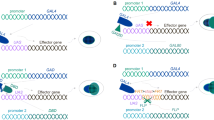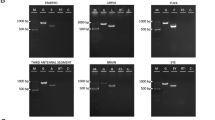Summary
The gene master mind (mam) is located in bands 50C23-D1 of the second chromosome of Drosophila melanogaster. mam is one of the neurogenic genes, whose function is necessary for a normal segregation of neural and epidermal lineages during embryonic development. Loss of function of any of the neurogenic genes results in a mis-routeing into neurogenesis of cells that normally would have given rise to epidermis. We describe here the molecular cloning of 198 kb of genomic DNA containing the mam gene. Ten different mam mutations (point mutants and chromosomal aberrations) have been mapped within 45 kb of the genomic walk. One of the mutations, an insertion of a P-element, was originally recovered from a dysgenic cross. Four different wild-type revertants of this mutation were characterized at the molecular level and, although modifications of the insertions were found, in no case was the transposon completely excised. An unusually high number of the repetitive opa sequence, and of an additional previously unknown element, which we have called N repeat, are scattered throughout the 45 kb where the mam mutations map. The functional significance of these repeats is unknown.
Similar content being viewed by others
References
Artavanis-Tsakonas S, Muskavitch MAT, Yednobnick B (1983) Molecular cloning of Notch, a locus affecting neurogenesis in Drosophila melanogaster. Proc Natl Acad Sci USA 80: 1977–1981
Ashburner M (1972) Patterns of puffing activity in the salivary gland chromosomes of Drosophila. VI. Induction by ecdysone in salivary glands of D. melanogaster cultured in vitro. Chromosoma 38:255–281
Beachy PA, Helfand SL, Hogness DS (1985) Segmental distribution of bithorax complex proteins during Drosophila development. Nature 313:545–551
Bender W, Spierer P, Hogness DS (1983) Chromosomal walking and jumping to isolate DNA from the Ace and rosy loci and the bithorax complex in Drosophila melanogaster J Mol Biol 168:17–33
Cote B, Bender W, Curtis D, Chovnick A (1986) Molecular mapping of the rosy locus in Drosophila melanogaster Genetics 112:769–783
Doe CQ, Goodman CS (1985a) Early events in insect neurogenesis. I. Development and segmental differences in the pattern of neuronal precursor cells. Dev Biol 111: 193–205
Doe CQ, Goodman CS (1985b) Early events in insect neurogenesis. II. The role of cell interactions and cell lineage in the determination of neuronal precursor cells. Dev Biol 111:206–219
Engels WR (1984) A trans-acting product needed for P factor transposition in Drosophila. Science 226:1194–1196
Engels WR, Preston CR (1984) Formation of chromosome rearrangements by P factors in Drosophila Genetics 107:657–678
Frischauf AM, Lehrach H, Poustka A, Murray N (1983) Lambda replacement vectors carrying polylinker sequences. J Mol Biol 170:827–842
Grimwade BG, Muskavitch MAT, Welshons WJ, Yedvobnick B, Artavanis-Tsakonas S (1985) The molecular genetics of the Notch locus in Drosophila melanogaster Dev Biol 107:503–519
Hartenstein V, Campos-Ortega JA (1984) Early neurogenesis in wild-type Drosophila melanogaster. Wilhelm Roux Arch Dev Biol 193:308–325
Jackson FR, Bargiello TA, Yun SH, Young MW (1986) Product of per locus of Drosophila shares homology with proteoglycans. Nature 320:185–188
Kidd S, Lockett TJ, Young MW (1983) The Notch locus of Drosophila melanogaster. Cell 34:421–433
Kidwell MG, Kidwell JF, Sved JA (1977) Hybrid dysgenesis in Drosophila melanogaster. Genetics 86:813–833
Laughon A, Carroll SB, Storfer FA, Riley PD, Scott MP (1985) Common properties of proteins encoded by the Antennapedia complex gene of Drosophila melanogaster Cold Spring Harbor Symp Quant Biol 50:253–262
Lehmann R, Dietrich U, Jimenez F, Campos-Ortega JA (1983) On the phenotype and development of mutants of early neurogenesis in Drosophila melanogaster Wilhelm Roux Arch Dev Biol 192:62–74
Lindsley DL, Grell EH (1968) Genetic variations of Drosophila melanogaster. Carnegie Institute, Washington, Publ No 627
Maine EM, Salz HK, Cline TW, Schedl P (1985) The Sex-lethal gene of Drosophila: DNA alterations associated with sex-specific lethal mutations. Cell 43:521–529
Maniatis T, Fritsch EF, Sambrook J (1982) Molecular cloning. A laboratory manual. Cold Spring Harbor Laboratory, Cold Spring Harbor, New York
Maxam AM, Gilbert W (1980) Sequencing end-labeled DNA with base-specific chemical cleavages. Methods Enzymol 65: 499–560
McGinnis W, Shermoen AW, Beckendorf SK (1983) A transposable element inserted just 5′ to a Drosophila glue protein gene alters gene expression and chromatin structure. Cell 34:75–84
McGinnis W, Levine MS, Hafen E, Kuroiwa A, Gehring WJ (1984) A conserved DNA sequence in homoeotic genes of the Drosophila Antennapedia and bithorax complexes. Nature 308:428–433
Merriam J (1984) Cloned DNA by chromosome location. Drosophila Info Serv 60:1–9
O'Hare K, Rubin GM (1983) Structures of P transposable elements and their sites of insertion and excision in the Drosophila melanogaster genome. Cell 34:25–35
Pardue ML (1985) In situ hybridisation. In: Hames BD, Higgins SJ (eds) Nucleic acid hybridisation. IRL, Oxford Washington DC, pp 179–202
Pirotta V, Hadfield C, Pretorius GHJ (1983) Microdissection and cloning of the white locus and the 3B1-3C2 region of the Drosophila X chromosome. EMBO J 2:927–934
Poole SJ, Kauvar LM, Drees B, Kornberg T (1985) The engrailed locus of Drosophila: structural analysis of an embryonic transcript. Cell 40:37–43
Poulson DF (1937) Chromosomal deficiencies and the embryonic development of Drosophila melanogaster Proc Natl Acad Sci USA 23:133–137
Poulson DF (1950) Histogenesis, organogenesis and differentiation in the embryo of Drosophila melanogaster Meigen. In: Demerec M (ed) Biology of Drosophila Wiley, New York, pp 168–174
Preiss A, Rosenberg UB, Kienlin A, Seifert E, Jäckle H (1985) Molecular genetics of Krüppel, a gene required for segmentation of the Drosophila embryo. Nature 313:27–32
Reed KC, Mann DA (1985) Rapid transfer of DNA from agarose gels to nylon membranes. Nucleic Acids Res 13:7207–7221
Regulski M, Harding K, Kostriken R, Karch F, Levine M, McGinnis W (1985) Homeo box genes of the Antennapedia and bithorax complexes of Drosophila Cell 43: 71–80
Rubin GM, Kidwell MG, Bingham PM (1982) The molecular basis of P-M hybrid dysgenesis: the nature of induced mutations. Cell 29:987–994
Scherer G, Telford J, Baldari C, Pirotta V (1981) Isolation of cloned genes differentially expressed at early and late stages of Drosophila embryonic development. Dev Biol 86:438–447
Technau GM, Campos-Ortega JA (1985) Fate mapping in wildtype Drosophila melanogaster. II. Injections of horseradish peroxidase in cells of the early gastrula stage. Wilhelm Roux Arch Dev Biol 194: 196–212
Technau GM, Campos-Ortega JA (1986) Lineage analysis of transplanted individual cells in embryos of Drosophila melanogaster. II. Commitment and proliferative capabilities of neural and epidermal progenitors. Wilhelm Roux Arch Dev Biol 195:445–454
Vässin H, Vielmetter J, Campos-Ortega JA (1985) Genetic interactions in early neurogenesis of Drosophila melanogaster. J Neurogenet 2:291–308
Vieira J, Messing J (1982) The pUC plasmids, an M13mp7 derived system for insertion mutagenesis and sequencing with synthetic universal primers. Gene 19:259–268
Voelker RA, Greenleaf AL, Gyurivics H, Wiseley GB, Huang SM, Searles LL (1984) Frequent imprecise excision among reversions of a P element-caused lethal mutation in Drosophila Genetics 107:279–294
Wetter U (1984) Entwicklungsgenetische Untersuchungen am N-2G-Gen der Fruchtfliege Drosophila melanogaster, Diploma Thesis, University Cologne
Wharton KA, Yedvobnick B, Finnerty VG, Artavanis-Tsakonas S (1985a) opa: a novel family of transcribed repeats shared by the Notch locus and other developmentally regulated loci in Drosophila melanogaster Cell 40:55–62
Wharton KA, Johansen KM, Xu T, Artavanis-Tsakonas S (1985b) Nucleotide sequence from the neurogenic locus Notch implies a gene product that shares homology with proteins containing EGF-like repeats. Cell 43:567–581
Wilimzig M (1985) LiCl-boiling method for plasmid mini-preps. Trends in Genetics 1:158
Wright TRF (1970) The genetics of embryogenesis in Drosophila. Adv Genet 15:262–395
Author information
Authors and Affiliations
Additional information
Communicated by E. Bautz
Rights and permissions
About this article
Cite this article
Weigel, D., Knust, E. & Campos-Ortega, J.A. Molecular organization of master mind, a neurogenic gene of Drosophila melanogaster . Mol Gen Genet 207, 374–384 (1987). https://doi.org/10.1007/BF00331604
Received:
Issue Date:
DOI: https://doi.org/10.1007/BF00331604




